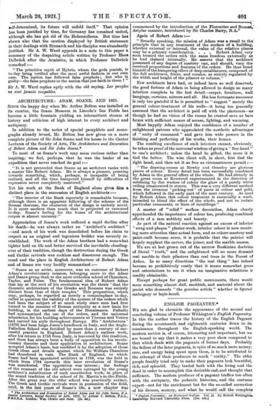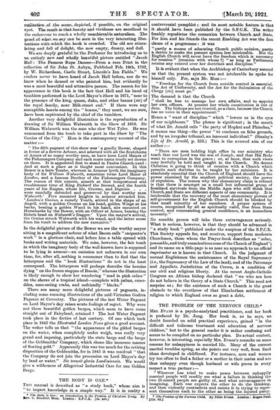ENGLISH PAGEANTRY.*
WE are glad to chronicle the appearance of the second and concluding volume of Professor Withington's English Pageantry. In this the author traces the history of the English Pageant during the seventeenth and eighteenth centuries down to its renaissance throughout the English-speaking world. The modern section is, of course, interesting and important, but we are bound to say that it makes a very poor show compared to that which deals with the pageants of former days. Probably the failure of the later pageants, in spite of so much more money, care, and energy being spent upon them, is to be attributed to the attempt of their producers to reach " reality." The older people frankly tried only to make their pageants look beautiful, rich, and splendid. They traded both with the living and the dead in order to accomplish this desirable end, and thought that sufficient. The modern producer of a pageant traffics too often with the antiquary, the pedantic historian, and the costume expert—not for the enrichment but for the so-called correction of his dresses, scenery, and what he would call the complete • Reeiish Pageantry : an Hielorical Outline. Vol. IL By Robert Witbinaton. Oam~ Harvard University Press. i25s. net.] realization, -,of the scene, depicted., if possible, on the original spot. The.resnit.iwthatheauty edul vividness are sacrificed to the endeavour to reach a wholly unankieVable natnrailisin. The propf.pf .what.,we -say can be seen in the very interesting illus. tratione, withawhich the book is crowded. The old are stimu- lating and. full- of delight, the new empty, dreary, and dull.
We .are .deeply grateful to:the Professor for introducing us to
an entirely new And wholly beautiful picture entitled ".Jacob Hall : The- Famous Rope Dancer—From a -rare Print in the
collection of Sir John St.' Aubyn, Published Feb. 18th, 1792,
by W. Richardson, Caatle 'Street, Lincoln!fr Inn Fields." We confess never to have heard of Jacob. Hall before, nor do we know when he danced or who painted him, but evidently he was a moat beautiful and attractive person. The reason for his appearance in this book is the fact that klall and his band of
tumblers performed in the Lord. Mayor's Show in 1671, " near to
the presence of the king, queen, duke, and other beams [sic} of the royal family, near .Milkatreet end." If there were any susceptible hearts among the " beams," they must, we are sure,
have been captivated by .the chief of the tumblers.
Another very delightful illustration is the reproduction of a drawing of Sir William Walworth in the Show of 1816. Sir William Walworth was the man who slow Wat Tyler. He was summoned from the tomb to take part in the Shaw by " The Genius of the City." Here is the contemporary account of the
matter
The fifth pageant of this show was a goodly Bower, shaped in forme of a fiowrie Arbour, and adorned with all the Seutchions of Armes of so many worthy men, as have been Lord Majors of the Fishmongers Company and each mans name truely set downs on them. It is appointed first to stand in Paules Church-yard : And at such a place as is thoght most convenient. In this Bower is a faire Tombe, whereon in Armour lyeth the imaginary body of Sir William Walworth, sometime twise Lord Maior -of London, and a famous Brother of the Fishmongers Company. The reason of this conceit, aimeth at that tempestuous and troublesome time of King Richard the Second, and the fourth years of his Reigns, whose life, Crowns, and Dignitie . . . were manfully defended and, preserved by that worthy man Walworth.' Five mounted knights in armour attended him. ' London's Genius, a comely Youth, attired in the shape of an Angell, with a golden Crowns on his head,.golden Wings at his backs, bearing a golden Wand in his, hand,, sits mounted, on Horsebaoke by the Bower, with an-Officer at Armes, bearing-the Rebels heed on Walt'orth's Dagger.' Upon the mayor's arrival, the Genius struck Walworth with his wand, and-the latter arose from his tomb to address the new executive."
In the delightful picture of thaBower we see the worthy mayor flitting in a magnificent arbour of what Bacon calls "carpenter's work " in a glorious chair, and before him a table spread •with books and writing materials. We miss, however, the fair tomb in which the imaginary body of the well-known hero is supposed to be lying in. armour—an omission not unknown in our own
time, for, after all, nothing is commoner than to find that the letterpress and the " book illustrations " do not in the least correspond. The letterpress will perhaps describe the heroine dying " on the frozen steppes of Russia," whereas the illustration is likely enough to show her wandering " mad in pink calico " on the shores of a tropical-island--complete with palms, croco-
diles, man-eating crabs, and unfriendly " blacks."
There are many more delightful pictures of pageants, in- cluding some amusing illustrations of the mid-Victorian Godiva Pageant at Coventry. The pictures of the last Water Pageant on Lord Mayor's day raises acute feelings of regret. Why were not these beautiful golden barges, which seem to have come straight out of Fairyland,. retained ? The last Water Pageant
took place in the forties of last century. Of one which took place in 1842 the Illustrated London. News gives a good account.
The writer tells us that " the appearance of the gilded barges on the water, when completely under weigh, was really very grand and imposing, particularly the state barge and the barge
of the Goldsmiths' Company, which shone like immense masses of floating gold." Apparently this was too much for the retiring disposition of the Goldsmiths, for in 1845 it was resolved "that the Company do not join the procession on Lord Mayor's day by land or .water." Sic transit gloria Lcmdiniensis. We would
give a wilderness of Allegorical Industrial Cars for one Golden Barge.



































 Previous page
Previous page